Safety in the vicinity of non-towered aerodromes - Australian ...
Safety in the vicinity of non-towered aerodromes - Australian ...
Safety in the vicinity of non-towered aerodromes - Australian ...
You also want an ePaper? Increase the reach of your titles
YUMPU automatically turns print PDFs into web optimized ePapers that Google loves.
DOCUMENT RETRIEVAL INFORMATION<br />
Report No.<br />
AR-2008-044(2)<br />
Publication date<br />
November 2010<br />
No. <strong>of</strong> pages<br />
132<br />
Publication title<br />
<strong>Safety</strong> <strong>in</strong> <strong>the</strong> vic<strong>in</strong>ity <strong>of</strong> <strong>non</strong>-<strong>towered</strong> <strong>aerodromes</strong><br />
Author(s)<br />
Taylor, R. P.<br />
Prepared By<br />
<strong>Australian</strong> Transport <strong>Safety</strong> Bureau<br />
PO Box 967, Civic Square ACT 2608 Australia<br />
www.atsb.gov.au<br />
Acknowledgements<br />
Front cover image courtesy <strong>of</strong> Phil Vabre.<br />
ISBN<br />
978-1-74251-093-4<br />
Reference Number<br />
ATSB-Sept10/ATSB124<br />
Abstract<br />
Most <strong>aerodromes</strong> <strong>in</strong> Australia are located <strong>in</strong> uncontrolled airspace and do not have an air traffic control<br />
presence. At <strong>the</strong>se <strong>non</strong>-<strong>towered</strong> <strong>aerodromes</strong>, and <strong>in</strong> <strong>the</strong> vic<strong>in</strong>ity <strong>of</strong> <strong>the</strong>m, pilots are responsible for<br />
mak<strong>in</strong>g <strong>the</strong>mselves aware <strong>of</strong> nearby aircraft and ma<strong>in</strong>ta<strong>in</strong><strong>in</strong>g separation. This report aims to give pilots<br />
an appreciation <strong>of</strong> <strong>the</strong> types <strong>of</strong> safety events that have been associated with operations at <strong>non</strong>-<strong>towered</strong><br />
<strong>aerodromes</strong> and provide education on expected behaviours to assist pilots <strong>in</strong> be<strong>in</strong>g prepared for <strong>the</strong><br />
risks.<br />
Generally, operations at <strong>non</strong>-<strong>towered</strong> <strong>aerodromes</strong> can be considered to be safe, but this relies on all<br />
pilots ma<strong>in</strong>ta<strong>in</strong><strong>in</strong>g awareness <strong>of</strong> <strong>the</strong>ir surround<strong>in</strong>gs and <strong>of</strong> o<strong>the</strong>r aircraft, and on fly<strong>in</strong>g <strong>in</strong> compliance<br />
with procedures, while be<strong>in</strong>g observant, courteous and cooperative. Most <strong>of</strong> <strong>the</strong> 709 airspace-related<br />
safety occurrences reported to <strong>the</strong> ATSB between 2003 and 2008 at, or <strong>in</strong> <strong>the</strong> vic<strong>in</strong>ity <strong>of</strong> <strong>non</strong>-<strong>towered</strong><br />
<strong>aerodromes</strong>, were <strong>in</strong>cidents, but <strong>the</strong>y also <strong>in</strong>cluded 60 serious <strong>in</strong>cidents and six accidents (mid-air and<br />
ground collisions). Most <strong>of</strong> <strong>the</strong> occurrences <strong>in</strong>volved conflicts between aircraft, or between aircraft and<br />
ground vehicles. The most common types <strong>of</strong> occurrences <strong>in</strong>volved <strong>in</strong>effective communication between<br />
pilots operat<strong>in</strong>g <strong>in</strong> close proximity, separation issues, <strong>in</strong>correct assessment <strong>of</strong> o<strong>the</strong>r aircraft’s positions<br />
and <strong>in</strong>tentions, rely<strong>in</strong>g on <strong>the</strong> radio as a substitute for an effective visual lookout, or a failure to follow<br />
published procedures.<br />
This report also documents changes <strong>in</strong> <strong>the</strong> number <strong>of</strong> aircraft movements and changes <strong>in</strong> <strong>the</strong> traffic mix<br />
<strong>in</strong>to 20 <strong>non</strong>-<strong>towered</strong> <strong>aerodromes</strong> s<strong>in</strong>ce 2003. Aerodromes experienc<strong>in</strong>g significant growth could<br />
potentially be exposed to higher risk. Port Macquarie, Kununurra, Ball<strong>in</strong>a, and Mt. Gambier all have<br />
experienced a recent <strong>in</strong>crease <strong>in</strong> large passenger transport aircraft movements.<br />
This report looked only at <strong>in</strong>cidents and accidents prior to <strong>the</strong> <strong>in</strong>troduction <strong>of</strong> changes by <strong>the</strong> Civil<br />
Aviation <strong>Safety</strong> Authority (CASA) to Civil Aviation Regulation (CAR) 166 on 3 June 2010, which<br />
affected procedures at all <strong>non</strong>-<strong>towered</strong> (<strong>non</strong>-controlled) <strong>aerodromes</strong>. Although <strong>the</strong> CAR 166 changes<br />
may <strong>in</strong> time be shown to reduce <strong>in</strong>cidents and accidents, a number <strong>of</strong> issues highlighted by <strong>the</strong><br />
occurrences documented <strong>in</strong> this report are likely to persist at <strong>non</strong>-<strong>towered</strong> <strong>aerodromes</strong>, but associated<br />
risks can be m<strong>in</strong>imised through greater awareness <strong>of</strong> <strong>the</strong> importance <strong>of</strong> clear and concise<br />
communications, effective visual lookout and adherence to published procedures.<br />
- vii -
















